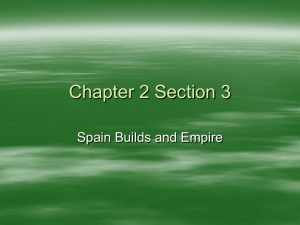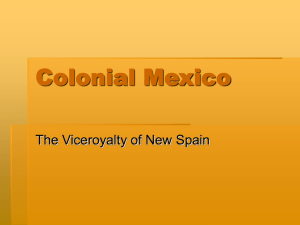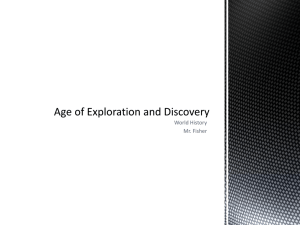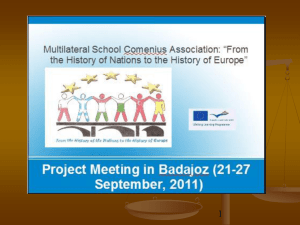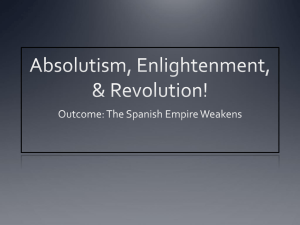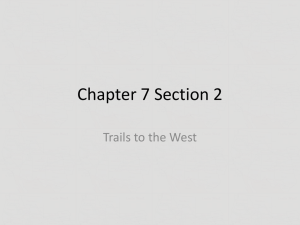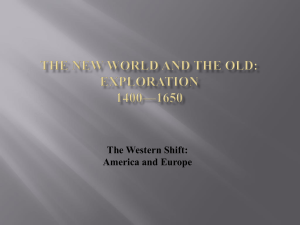Chapter 2
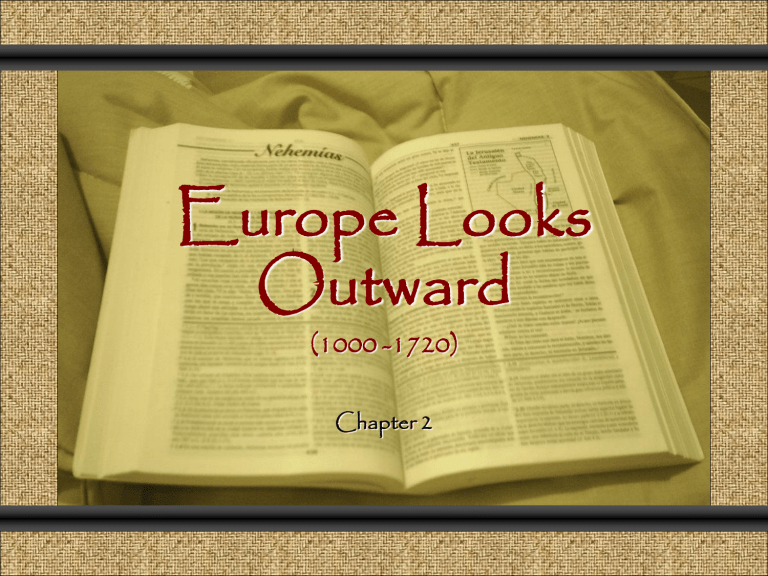
Comunicación y Gerencia
Europe Looks
Outward
(1000 -1720)
Chapter 2
Content Standards
• North America, originally inhabited by American
Indians, was explored and colonized by
Europeans for economic and religious reasons.
- History Standard #2
1.
I can explain the economic reasons behind the European exploration of North America.
2.
I can explain the religious reasons behind the European exploration of North America.
• Competition for control of the territory and resources in North
America led to conflicts among colonizing powers.
3.
I can explain how competition for control of territory and resources in North America led to conflicts among colonizing powers
.
- History Standard #3
Quick-Write
What do you know about the following:
1.Who discovered America and what were they looking for?
2.All-Water Route to Asia . . . What was it, and why was it important?
3.The Columbian Exchange . . . What was it, and why was it important?
Fir
First Visitors from Europe
Native Americans (Asia) Vikings (Scandinavia)
Christopher Columbus
• Spain v/s Portugal born?
• Studied sailing, maps, and charts.
• All-Water Route to Asia . .
. Thought it would only take 21 days
• Who financed the trip after 6 years of waiting?
What he REALLY did :
• Nina, Pinta, and Santa
Maria (1492)
• West Indies (Nicknamed the Natives “Indians”)
• Cuba (Japan?)
• Island of Hispaniola
• Returned Home 1493
• What did he do for
Spain?
Spain Backs MORE Voyages
Christopher Columbus
• Four voyages
• Gold/Forced Labor
• Claimed land for Spain
• Converting Natives to
Christianity
• Enslavement of Locals
• South America (Northern
Coast) “ . . . Asia?”
Others
• Amerigo Vespucci
• Vasco Nunez de Balboa
• Ferdinand Magellan
The Columbian Exchange
The “Exchange” of people, products, and ideas between the Eastern and Western Hemispheres
Spain’s Empire in the
Americas
Chapter 2 Section 2
Hernan Cortes
• Conquered Cuba for
Spain
• Heard tales about cities of gold across the Gulf of Mexico
• Cortes went against
Spain’s wishes and set out with 11 ships,
600 Spanish soldiers, and 200
Cubans.
Tenochtitlan
Quetzalcoatl
• An Aztec legend of a pale-skin, feathered
Serpent god .
• . . . “the feathered
Serpent has returned to the
Aztec Empire to reclaim his throne.
If he comes, he strikes at kings.”
• “Our lord and king
. . . They have arrived at the shores of the great sea. Their weapons and equipment are all made of iron. Their bodies are covered everywhere; only their faces can be seen. They are white, as if made of lime.”
Montezuma sends messengers with gifts . . .
• Golden masks inlaid with turquoise
• Headdresses with bright feathers
• Gold jewelry and shields
Hernan Cortes
• Pale-faced stranger
• Spanish conquistador
• “Is this all? I and my friends suffer from a disease of the heart which only gold can cure!”
Greed . . . Fear
• After leaving the coast, Cortes founded a colony and named it Veracruz. . . Claiming Mexico for Spain and the Catholic Church.
• Montezuma continued to send sacks of gold in hopes that the Spaniards would be satisfied and turn back before reaching the city.
• The Spaniards ended up with about $8 million worth of Aztec Gold.
The Fall of the Aztec Empire
• Montezuma’s capture and death
• Spaniards retreat
• The “great sickness” hits the Aztecs
(smallpox/measles?)
• Mounted soldiers returned with guns and other native tribes
• Aztec Empire conquered
. . . capital of “New
Spain” is Mexico City.
The Incan Empire
• Conquistadors explored the West coast of South
America looking for gold and silver
• The Incan ruler was
Atahualpa
• Atahualpa was in a civil war with his half-brother
Francisco Pizarro
• (1526) captured an
Incan trading boat loaded with silver and gold
• Used the crew as interpreters and led an attack on the Incan
Empire
The Fall of the Incan Empire
• Pizarro and his men captured the Incan capital of Cuzco and held
Atahualpa for ransom promising to let him go once they were paid . . . They never kept their promise.
• Part of the Incan Empire held out against the Spaniards for almost 40 years . . . unlike the Aztecs who fell in two years.
• The Spaniards found far more gold in South America than in
Mexico . . the Incan Empire became Spain’s richest colony.
Defeated by Cortes and Pizarro
How/Why?
Spain Builds a Vast Empire
•New wealth
•Expansion of
Navy & Army
Explorations
•Settlements in the new
Americas
Other Spanish Explorers
• Juan Ponce de Leon
• Alva Nunez Cabeza de Vaca
• Francisco Coronado
• Hernando de Soto
Spain’s American Empire
New Spain
Northern Empire
Peru
Southern Empire
Viceroy
• The governing officials put in charge of “New
Spain” and “Peru”
• Responsible for producing wealth for
Spain
• Rich deposits of silver, cotton, sugarcane, and other crops grown on plantations
Missions
• Religious communities that usually included a small town surrounding farmland and a church
• Started by Catholic religious workers called
• Natives are taught religion, crafts, and skills
Social Classes in New Spain
•Peninsulares
•Creoles
•Mestizos
Forced Labor (Slavery?)
• Native Americans made up the largest group of people in
Spain’s empire.
• Forced to work in the mines and on plantations under cruel conditions.
The Spanish Crown
• Gave plantation owners the right to demand labor from the Native
Americans
• In return they had to pay Native Americans their wages, ensure their security, and instruct them in the
Roman Catholic religion.
Spanish Explorers
The Spanish “Borderlands”
• Explorers turned their attention to the borderlands looking for gold. . . Alvar Nunez
Cabeza de Vaca
• Juan Ponce de Leon – (Florida) searching for the fountain of youth
• Francisco Vasquez de Coronado-
(Southwestern) searching for the Seven
Cities of Gold
• Hernando de Soto- (present-day South
Carolina, Georgia, Alabama, Mississippi, and
Tennessee) searching for the Seven Cities of
Gold
Missions in the Borderlands
• Instead of soldiers, the government sent missionaries to start new settlements
• From the 1560s – 1820s, Spain set up hundreds of missions in present-day New
Mexico, Arizona, Texas , California
Florida, and Georgia
Restrictions on Native Americans
- Could not leave without permission
- daily activities were scheduled to attend
- Forced to give up their own religious beliefs and traditions
*Many Native Americans rebelled . . .
Some attacked missions and missionaries or just simply left.
Death Tolls for the Natives Rise
• Disease
• Forced labor
• Tunnels caving
Africans were brought to the Caribbean . . .
Europeans Compete in
North America
Chapter 2 Section 3
Reformation
• Protestant
Movement
• Martin Luther
• John Calvin
Religion & King Henry VIII
• (1534) King Henry VIII broke away from the
Catholic Church
• Scandal/Divorce
• “The Church of England”
• England became a
Protestant country
Mercantilism
• A country could be rich only if wealth continually flowed into its economy and its government treasury.
• It was the colonists duty to ship most of the gold, silver, or other resources found in the colony back to their home country in Europe.
*Spain was the first European country to set up colonies in the Americas (with the use of mercantilism).
Mercantilism
• The colonies existed to make the “Home/Mother” country wealthy and powerful.
The Spanish
Armada
• Passing of King Henry VIII (Protestant) . . . Queen Mary I (Roman
Catholic) . . . Queen Elizabeth I (Protestant)
• Rivalry w/”Roman Catholic” Spain
• English raids on Spanish ships (Gold) . . . Aide to rebels (Holland)
• King Phillip (130 warships) . . . Off the coast of France
• Spanish defeated and weakened . . .
NORTHWEST PASSAGE ?
• Can you reach Asia by going through or around the Arctic Ocean ?
Henry Hudson
•Henry Hudson’s Voyages
France and the Netherlands in North America
Chapter 2 Section 3
Samuel de Champlain
• Fur companies hired Champlain and paid for his expedition to lead the first French attempt at settling in America.
• Champlain established Quebec (the 1 st permanent French settlement)
• Quebec City and Montreal . . . Trade centers
French Exploration
• Jacques Cartier claimed eastern
Canada for France . .
. He never found an all water route to the east, nor did he find silver or gold.
• Cartier reported that there were a great many furbearing animal in North
America
Other French Explorers
• Jacques Marquette
(Missions) and Louis
Joliet (trader). . .
Explored the Great
Lakes and the
Mississippi River
• Rene Robert Cavelier
(AKA LaSalle) claimed the
Mississippi River
Valley (Louisiana)
The French and the Native
Americans
The French:
• Learned the Native American languages
• Studied their customs and cultures
• Instead of changing their ways . . . They accepted their ways
* Champlain was known as the “Father of
New France”
The French Fur Trade
• “New France’s” economy was based on fur trade . . . Beaver, otter, fox, etc. . .
• Fur was very fashionable in Europe
• Rivers were used as highways to travel across New France
• Trading posts were set up along the way and Native Americans became friendly with them and began to help and trade
The French Empire
• Trappers, traders, priests, and soldiers continued to move into the lands that
France had claimed.
• Many trading posts and forts were built
(Detroit, St. Louis, and New Orleans)
Land Grants
• Cold weather and attacks by the Iroquois kept many people from leaving France.
• The government and economy in France was stable . . . No reason for people to leave.
• King Louis XIV set up a land grant system to encourage people to settle.
• Land was given to
French nobles for getting people to settle there and farm the land.
• The French government set up military forts that connected Canada with Louisiana and its claims along the
Mississippi River.
New Netherlands &
New Sweden
Henry Hudson
(1609)
The “New” Netherlands
1621 – Dutch West India
Company sets up a trading company
1624 – Sent 30 families to settle
New Amsterdam– center of new colony located on Manhattan
Island
Purchased from
Native Americans
Grows slowly - No real reason to move there.
Their country was prosperous and tolerant of religions
New York City
1626 – Peter Minuit , governor of colony, buys land for about $24-$26
(beads, knives, etc…)
Swedes in New Netherlands
Mid-1600s Sweden in Golden Age settled small, under-funded colony
[called “New Sweden”] near New
Netherland.
1655 Dutch under director-general
Peter Stuyvesant attack New Sweden.
Main fort fell after bloodless siege.
New Sweden absorbed into New Netherland.
New Amsterdam,
1664
New English King Takes Over
* Civil War in England between
Parliament (mainly
Puritans) and supporters of
Charles I.
* King beheaded for treason.
• Puritans run country for 11 years
* 1660 – King Charles II takes over
New Netherlands Becomes a
British Royal Colony
Charles II granted New Netherland’s land to his brother, the Duke of York, [before he controlled the area!]
1664 English soldiers arrived.
Dutch had little ammunition and poor defenses.
Stuyvesant forced to surrender without firing a shot.
Renamed “New York”
England gained strategic harbor between her northern & southern colonies.
England now controlled the Atlantic coast!
The Impact on Native
Americans
Pros Cons
• Furs
• Manufactured Goods . . . cloth, iron pots, tools, and guns
• Huron/French
• Iroquois/Dutch
• Competition for fur
• Tribal Enemies
• Dutch had guns
• Native American attacks
• Depletion of fur-bearing animals
• Disease
Native Americans’ value to the colonist decreased, yet their land became more valuable.
Review
Describe the impact that the
Spanish
had on
Native Americans in North America.
Describe the impact that the
French
had on
Native Americans in North America.
Describe the impact that the
Dutch
had on
Native Americans in North America.
What is
Mercantilism
?
